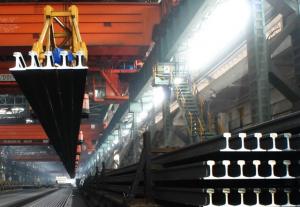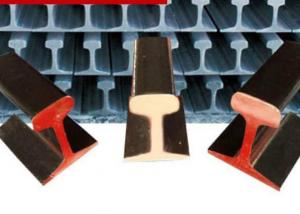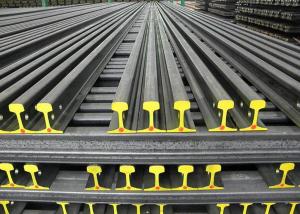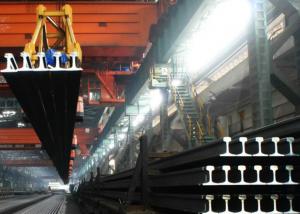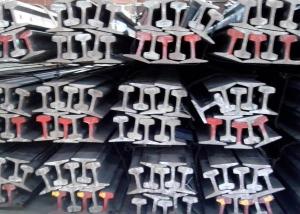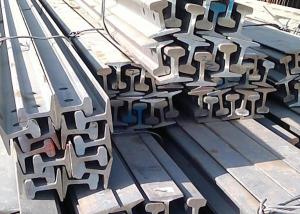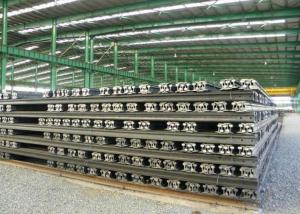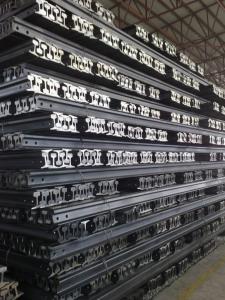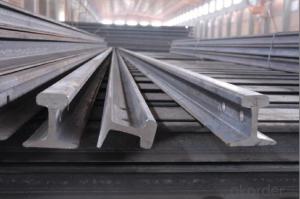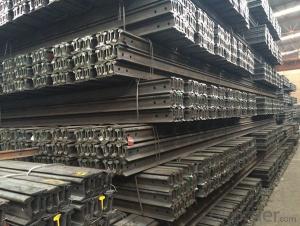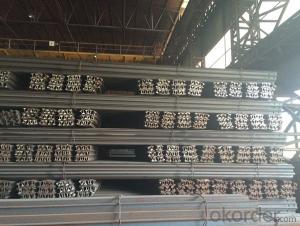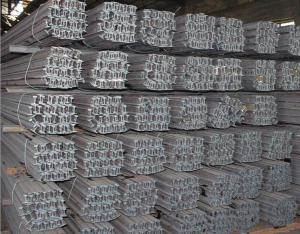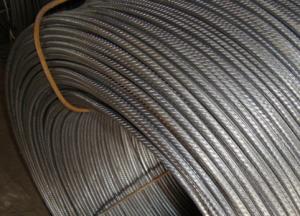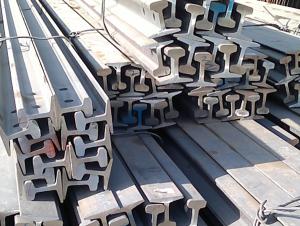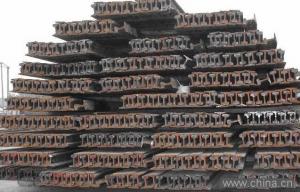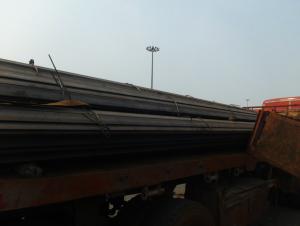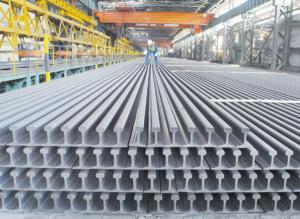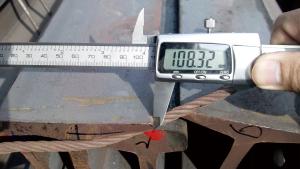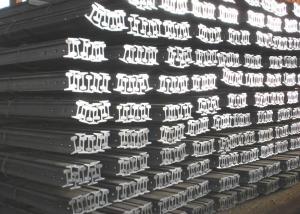Light Steel Rail GB 9kg GB12kg GB15kg with High Quality
- Loading Port:
- China main port
- Payment Terms:
- TT or LC
- Min Order Qty:
- 25 m.t.
- Supply Capability:
- 100000 m.t./month
OKorder Service Pledge
OKorder Financial Service
You Might Also Like
Product Description of Light Steel Rail GB 9kg GB12kg GB15kg with High Quality:
Sizes: 38kg, 43kg, 45kg, 50kg, 60kg.
Production Standard: GB2585-81, DIN, AREMA, JIS, BS, UIC, etc.
Material: 50MN, U71MN, 900A, 110A, etc.
Length: 6m-25m according to the requriements of the clients
Alloy No | Grade | Element(%) | ||||
C | Mn | S | P | Si | ||
Q235 | B | 0.12—0.20 | 0.3—0.7 | ≤0.045 | ≤0.045 | ≤0.3 |
Usages of Light Steel Rail GB 9kg GB12kg GB15kg with High Quality:
Light rail is mainly used in forest region, mines, factories and construction sites laid of the place such as temporary transport line and light motorcycles with line. Be widely used for railway, subway, transportation track, express, curve way, tunnel way and so on.
Packaging & Delivery of Light Steel Rail GB 9kg GB12kg GB15kg with High Quality:
1. Packing: it is nude packed in bundles by steel wire rod
2. Bundle weight: not more than 3.5MT for bulk vessel; less than 3 MT for container load
3. Marks:
Color marking: There will be color marking on both end of the bundle for the cargo delivered by bulk vessel. That makes it easily to distinguish at the destination port.
Tag mark: there will be tag mark tied up on the bundles. The information usually including supplier logo and name, product name, made in China, shipping marks and other information request by the customer.
If loading by container the marking is not needed, but we will prepare it as customer request.
4. Transportation: the goods are delivered by truck from mill to loading port, the maximum quantity can be loaded is around 40MTs by each truck. If the order quantity cannot reach the full truck loaded, the transportation cost per ton will be little higher than full load.
5. Delivered by container or bulk vessel
6. Delivery Time: All the Hot Rolled Steel Rail will be transpoted at the port of Tianjin, China within 30 days after receiving the advance payment by T/T or the orginal L/C at sight.
Inspection of Light Steel Rail GB 9kg GB12kg GB15kg with High Quality:
We will send the MTC of the factory to the clients dirrectly which contain the anlisis of the heat, chemiqul composition, phisical characteristicas, etc.
And our inspectors will arrive at the factory to meke the inspection of the size, length, weight and quantity before the transportation from the factory.
FAQ:
Q1: How soon can we receive the product after purchase?
A1: Within three days of placing an order, we will begin production. The specific shipping date is dependent upon international and government factors, but is typically 7 to 10 workdays.
Q2: Can stainless steel rust?
A2: Stainless does not "rust" as you think of regular steel rusting with a red oxide on the surface that flakes off. If you see red rust it is probably due to some iron particles that have contaminated the surface of the stainless steel and it is these iron particles that are rusting. Look at the source of the rusting and see if you can remove it from the surface.
Q3: Why buy Materials & Equipment from OKorder.com?
A3: All products offered by OKorder.com are carefully selected from China's most reliable manufacturing enterprises. Through its ISO certifications, OKorder.com adheres to the highest standards and a commitment to supply chain safety and customer satisfaction.
Images:
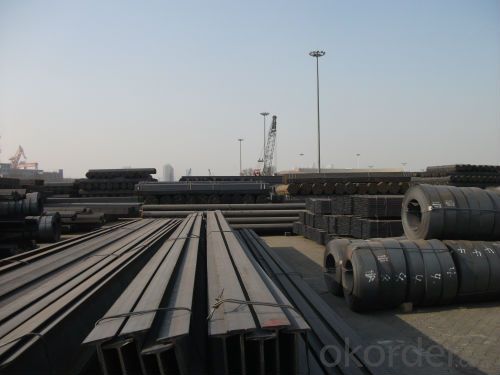
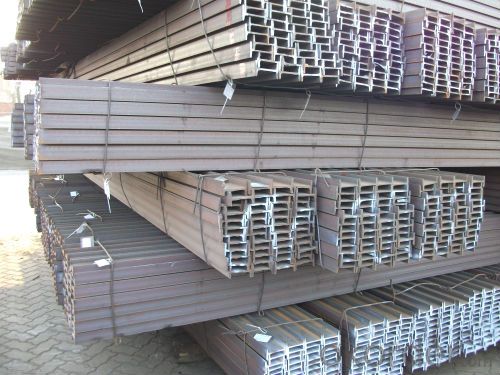
- Q: Are steel rails affected by seismic activities or ground movements?
- Yes, steel rails can be affected by seismic activities or ground movements. Seismic activities, such as earthquakes, can cause ground shaking and ground displacement, which can lead to the misalignment or damage of steel rails. Ground movements, such as landslides or subsidence, can also impact the stability and alignment of steel rails, potentially causing derailments or track failures. Therefore, it is important to consider these factors when designing and maintaining railway infrastructure in seismic-prone areas.
- Q: What is the average cost of maintaining steel rails?
- The average cost of maintaining steel rails can vary depending on a range of factors such as the length of the rail line, the frequency of usage, the specific maintenance activities required, and the condition of the rails. Typically, the cost of maintaining steel rails includes regular inspections, cleaning, lubrication, and repairs. These activities aim to detect and address issues such as wear and tear, corrosion, and alignment problems. In some cases, more extensive maintenance tasks like rail grinding or replacement may be needed. It is difficult to provide an exact average cost as it can differ significantly depending on the specific circumstances. However, it is generally estimated that the maintenance cost for steel rails can range from a few thousand to tens of thousands of dollars per mile annually. This cost may increase if additional maintenance or repairs are necessary due to factors like heavy usage, harsh weather conditions, or inadequate previous maintenance. To determine the average cost for maintaining steel rails in a particular situation, it is recommended to consult with rail maintenance specialists or relevant industry experts who can assess the specific needs and provide a more accurate estimate based on the unique circumstances.
- Q: How do steel rails handle changes in track alignment due to settlement?
- Steel rails are designed to handle changes in track alignment due to settlement by flexing and adjusting to the shifting track. The steel material allows for some degree of movement and flexibility, which helps the rails to maintain stability and continue to provide a smooth and safe passage for trains, even in the event of settlement. Additionally, regular maintenance and inspection of the tracks are conducted to identify and address any alignment issues promptly, ensuring the continuous integrity of the rail system.
- Q: Are steel rails used for both heavy and light rail systems?
- Yes, steel rails are used for both heavy and light rail systems. Steel is the most commonly used material for rail tracks due to its durability, strength, and ability to withstand heavy loads. Whether it is for heavy rail systems, such as commuter trains or freight trains, or light rail systems, like trams or streetcars, steel rails provide a stable and reliable foundation for the smooth movement of trains. The size and weight of the rail may vary depending on the specific requirements of the rail system, but the use of steel rails remains consistent across both heavy and light rail systems.
- Q: Can steel rails be used for roller coasters?
- Yes, steel rails can be used for roller coasters. In fact, steel is the most commonly used material for roller coaster tracks due to its strength, durability, and ability to withstand the intense forces and high speeds experienced by roller coasters.
- Q: How do steel rails compare to other rail materials, such as iron or aluminum?
- Steel rails have several advantages when compared to other rail materials such as iron or aluminum. Firstly, steel rails are known for their exceptional strength and durability. Steel has a high tensile strength, which means it can withstand heavy loads and intense pressure without deforming or breaking. This makes steel rails ideal for carrying heavy freight trains or high-speed passenger trains. In comparison, iron rails are relatively weaker and more prone to wear and tear, while aluminum rails are even less sturdy and more susceptible to bending or warping under stress. Secondly, steel rails have a longer lifespan than other rail materials. Steel is highly resistant to corrosion and rust, which ensures that the rails remain in good condition for an extended period of time. Iron rails, on the other hand, are more prone to rusting, which can weaken the structure and require frequent maintenance. Aluminum rails are also susceptible to corrosion and can deteriorate quickly. Another advantage of steel rails is their compatibility with modern rail systems. Steel is a versatile material that can be easily welded, allowing for seamless connections between rails and easy maintenance. Iron rails, on the other hand, are typically joined using fishplates, which can cause slight disruptions in the smoothness of the track. Aluminum rails are not commonly used in rail systems due to their lower strength and structural integrity. Furthermore, steel rails offer better track stability and reduced vibration. The high density of steel provides a solid foundation for trains to travel on, minimizing the risk of derailment and ensuring a smoother ride. Iron rails, being less dense, may cause more vibrations and noise. Aluminum rails, with their lower density, can create even more vibrations and noise, leading to a less comfortable journey for passengers. Overall, steel rails outperform other rail materials in terms of strength, durability, lifespan, compatibility, and track stability. These advantages make steel the preferred choice for rail systems worldwide, ensuring safe and efficient transportation for both freight and passengers.
- Q: How are steel rails used in railway electrification systems?
- Steel rails are a crucial component in railway electrification systems as they serve as the primary conductors of electrical current. These rails are specifically designed to provide a reliable path for the flow of electricity, enabling the efficient transfer of power from the power supply to the trains. In railway electrification systems, the steel rails act as the positive conductor, carrying the direct current (DC) to power the electric locomotives or trains. The rails are installed in a continuous track configuration, ensuring a consistent and uninterrupted power supply throughout the railway network. To facilitate electrical conductivity, the steel rails are typically made of high-quality steel that has excellent electrical conductivity properties. They are also manufactured with precision to ensure uniformity and consistency in electrical resistance across the entire railway network. The electrification system is based on the principle of using a pantograph, which is mounted on the roof of the train, to collect electricity from the overhead lines or catenary wires. As the train moves along the tracks, the pantograph maintains contact with the overhead lines, allowing the electrical current to flow from the wires to the steel rails. The steel rails not only serve as conductors but also provide mechanical support to the trains. They ensure smooth movement of the trains by guiding the wheels along the track and distributing the weight of the train evenly. This combination of electrical conductivity and mechanical stability makes steel rails an essential component in railway electrification systems. Overall, steel rails play a critical role in railway electrification systems by providing a reliable path for the flow of electricity, enabling the efficient transfer of power to the trains. They are designed to ensure both electrical conductivity and mechanical stability, making them indispensable for the smooth and reliable operation of electric trains in modern railway networks.
- Q: What is the role of steel rails in reducing noise pollution?
- The reduction of noise pollution is a crucial function of steel rails. Firstly, their design ensures a smooth surface for train wheels to travel on, minimizing vibrations and jolts that generate noise as trains pass over the tracks. This reduction in vibrations plays a key role in minimizing overall train noise. Secondly, steel rails are constructed to be durable and robust, enabling them to withstand heavy loads and maintain their shape over time. This structural integrity prevents excessive wear and tear on the track, thereby reducing noise caused by loose or misaligned rails that can result in rattling or screeching sounds. Moreover, steel rails are often equipped with noise-dampening measures, such as the use of resilient materials like rubber or polyurethane between the rail and its support system. These materials effectively absorb and dampen the vibrations and impacts caused by passing trains, further reducing emitted noise. Additionally, the smooth surface finish of steel rails helps minimize noise resulting from friction between train wheels and tracks. This significantly reduces the high-pitched squealing or grinding sounds that can occur when trains are in motion. In conclusion, steel rails play a significant role in diminishing noise pollution associated with train operations. Their provision of a smooth surface, structural stability, and noise-dampening features all contribute to creating a quieter and more comfortable environment for both passengers and nearby residents.
- Q: How are steel rails protected against extreme cold temperatures?
- Steel rails are typically protected against extreme cold temperatures through a process called "thermite welding." This involves using a mixture of aluminum powder and iron oxide to generate high temperatures and fuse the steel rails together, ensuring their strength and durability even in freezing conditions. Additionally, steel rails are often coated with specialized anti-corrosion materials that provide an extra layer of protection against the harsh effects of cold weather.
- Q: How are steel rails protected against impact and shock loads?
- To ensure the safety and efficiency of railway operations, steel rails undergo various measures to withstand impact and shock loads. This involves the use of high-quality steel materials with excellent strength and durability properties, specifically chosen for their high tensile strength. The shape and profiles of the rails are carefully designed to distribute forces evenly and reduce stress concentrations, minimizing the risk of deformation or failure. A well-designed and maintained track system, including sleepers made of concrete or timber and a layer of crushed stones called ballast, further absorbs and dissipates impact and shock loads. Fastening systems such as rail clips and bolts are employed to secure the rails to the sleepers and prevent excessive movement or displacement. Regular inspection and maintenance, including ultrasonic testing and visual inspections, promptly address any defects or damages to maintain the safety and reliability of the rail system. Overall, these measures collectively ensure the durability and safety of steel rails in withstanding the forces generated by impact and shock loads.
Send your message to us
Light Steel Rail GB 9kg GB12kg GB15kg with High Quality
- Loading Port:
- China main port
- Payment Terms:
- TT or LC
- Min Order Qty:
- 25 m.t.
- Supply Capability:
- 100000 m.t./month
OKorder Service Pledge
OKorder Financial Service
Similar products
Hot products
Hot Searches
Related keywords
